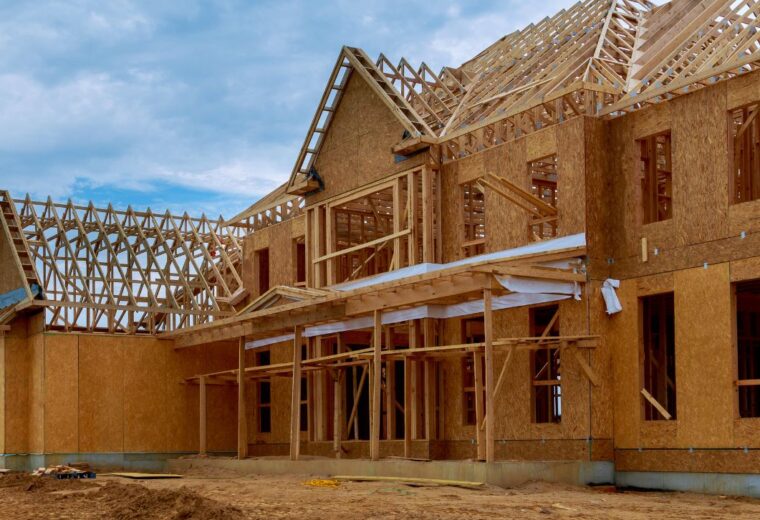Ground-up construction projects represent some of the most ambitious endeavors in real estate, demanding substantial capital investment, meticulous planning, and a solid understanding of market dynamics. Unlike renovations or smaller expansions, building from the ground up means creating something entirely new, often with a long lead time from conception to completion. This inherent multi-year timeline makes these projects particularly susceptible to the ebb and flow of economic trends. For developers, investors, and anyone involved in this sector, comprehending these economic currents isn’t just beneficial – it’s essential for success.
At Express Capital Financing, we go beyond providing funding; we’re invested in helping real estate developers and investors navigate the challenges and opportunities of ground-up construction with confidence. We share insights into economic dynamics so our partners can make informed, profitable decisions.
In this article, we’ll explore the critical economic factors impacting ground-up construction projects, helping you understand how to proactively shape your strategies and capitalize on opportunities in an ever-changing landscape.
Interest Rates: The Cost of Capital
Few economic factors have a more direct influence on construction projects than interest rates. The borrowing costs tied to interest rates ripple through every aspect of a project, from land acquisition to construction materials. Staying ahead of these fluctuations is key to maintaining project feasibility.
Rising Interest Rates: When interest rates climb, the cost of financing for developers increases. This directly impacts project viability by reducing profit margins. Higher borrowing costs can make otherwise attractive projects financially unfeasible, leading to delays, cancellations, or a scaling back of ambition.
For example, you might reconsider building a luxury apartment complex if the increased cost of a construction loan makes the projected rental income insufficient to cover expenses and generate a healthy return. Find out more about how to maximize your rental returns with ground-up construction.
Higher interest rates also tend to cool the demand for new homes or commercial spaces, as mortgages become more expensive for buyers and businesses face higher costs for new facilities. This can lead to an oversupply of new units in the market, further dampening developer confidence.
Falling Interest Rates: Conversely, declining interest rates often act as a catalyst for ground-up construction. Cheaper borrowing makes projects more attractive, expanding profit margins and encouraging new development. Lower mortgage rates can stimulate housing demand, while more affordable commercial loans can spur businesses to expand or relocate, driving demand for new office buildings, retail spaces, or industrial facilities. This often leads to a boom in ground-up construction, characterized by increased project starts and accelerated timelines.
Inflation: The Rising Tide of Costs
Inflation, the general increase in prices for goods and services over time, is a formidable adversary for ground-up construction. From skyrocketing material prices to wage increases and operational costs, inflation can quickly strain budgets and timelines..
Material Costs: The most immediate and visible effect of inflation is on building material costs. Prices for essentials like steel, timber, concrete, copper, and even basic finishes can skyrocket, turning initial budget estimates into significant underestimations. Supply chain disruptions, often exacerbated by global events, can further compound these price increases and lead to material shortages, causing project delays and forcing developers to pay premium prices for scarce resources.
Labor Costs: Inflation also pushes up labor costs. As the cost of living increases, workers demand higher wages to maintain their purchasing power. This can lead to increased payroll expenses for contractors, further inflating the overall project cost. The ongoing skilled labor shortage in the construction industry often amplifies this issue, as competition for qualified workers drives wages even higher.
Equipment and Fuel: Beyond materials and labor, the cost of renting or purchasing heavy equipment and the price of fuel for transportation and machinery operation also rise with inflation. These seemingly smaller line items can add up significantly throughout a large-scale ground-up project.
Supply Chain Disruptions: The Unpredictable Bottleneck
The globalized nature of modern construction means that projects are highly dependent on complex supply chains. Recent years have vividly demonstrated how fragile these networks can be, with far-reaching consequences for ground-up construction.
Delays and Shortages: Events like natural disasters, pandemics, geopolitical conflicts, such as Trump’s tariffs, or even a surge in demand can disrupt the flow of materials and components. This can lead to significant delays in project timelines as contractors wait for critical supplies to arrive. Shortages also drive up prices, as seen during the post-pandemic construction boom.
Increased Costs: Beyond the direct cost of materials, supply chain disruptions can lead to higher shipping costs, increased storage expenses due to delayed deliveries, and even penalties for missed deadlines. Projects might also be forced to use alternative, more expensive materials if their preferred options are unavailable.
Project Uncertainty: The unpredictability of supply chain issues introduces a significant layer of risk and uncertainty into project planning. Developers may find it challenging to provide firm completion dates or fixed prices, which can deter potential buyers or tenants.
Labor Shortages: The Human Capital Conundrum
The construction industry, particularly in the skilled trades, has faced persistent labor shortages for years. This trend has a profound impact on ground-up projects, from timelines to overall costs.
- Increased Labor Costs: A scarcity of skilled workers naturally drives up wages. This directly impacts project budgets and can make it challenging for contractors to find enough qualified personnel to complete projects on time and to the required standards.
- Project Delays: Without sufficient labor, projects can fall behind schedule, leading to extended interest payments on loans, increased overheads, and potential penalties for late completion.
- Quality Control Issues: A strained workforce may also lead to compromises in quality if workers are overworked or less experienced individuals are brought in to fill gaps.
Economic Growth and Consumer Confidence: The Demand Driver
The broader economic climate and the level of consumer and business confidence are fundamental drivers of demand for new construction.
- GDP Growth: A robust Gross Domestic Product (GDP) signifies a healthy economy, which typically translates into increased demand for both residential and commercial real estate. When businesses are expanding and consumers have disposable income, there’s a greater need for new housing, office spaces, retail centers, and industrial facilities.
- Employment Rates: Low unemployment rates indicate a strong job market, leading to higher consumer confidence and increased purchasing power. This fuels demand for housing and commercial spaces, as businesses grow and individuals seek new homes or upgraded living situations.
- Consumer and Business Sentiment: Beyond hard data, the general sentiment of consumers and businesses plays a crucial role. If individuals are optimistic about their financial future, they are more likely to invest in real estate. Similarly, confident businesses are more inclined to expand their operations, requiring new construction.
Government Policies and Regulations: The Regulatory Landscape
Government policies and regulations at the federal, state, and local levels can significantly influence the feasibility and cost of ground-up construction.
- Zoning Laws and Permitting: Stringent zoning laws, lengthy permitting processes, and complex environmental regulations can add significant time and cost to projects. Delays in approvals can lead to increased holding costs and push back construction start dates.
- Building Codes and Safety Standards: Evolving building codes and increased safety standards, while crucial for public welfare, can necessitate more expensive materials or construction methods, adding to project costs.
- Infrastructure Spending: Government investment in infrastructure projects (roads, bridges, utilities) can create opportunities for ground-up development by improving accessibility and supporting growth in specific areas. Conversely, a lack of investment can hinder development.
- Tax Incentives and Subsidies: Government incentives, such as tax credits for affordable housing or renewable energy projects, can significantly improve the financial viability of certain ground-up developments.

Building On A Solid Foundation
For ground-up construction projects, predicting and adapting to economic trends is not a luxury – it’s a necessity. At Express Capital Financing, we pride ourselves on being more than just a lender; we are a strategic partner committed to your success.
Our ground-up construction loans are specifically designed to address the unique challenges and opportunities presented by varying economic climates. We offer:
- Flexible Lending Solutions: Whether you’re building single-family residences, multi-unit complexes, or mixed-use developments, we offer tailored financing solutions for all project sizes.
- Expedited Approvals and Funding: Our streamlined underwriting process and in-house support mean quick approvals and fast funding.
- Transparent Terms: Avoid hidden fees and prepayment penalties with our clear, straightforward loan terms.
- Expert Guidance: Our team’s deep knowledge of economic trends provides you with actionable insights to mitigate risk and maximize returns.
Successful ground-up construction requires foresight, adaptability, and access to capital designed for fluctuating market conditions. Express Capital Financing stands ready to be your partner, providing the capital and expertise you need to build bigger, faster, and with greater confidence. Ready to Build? Contact us today.






